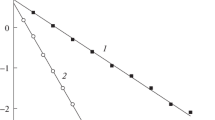Abstract
The rate of the reversible homogeneous disproportionation of polysulfides was studied by following the optical absorbance of polysulfide solutions in a continuous plug flow reactor equipped with an on-line photometric detector. In order to avoid heterogeneous slow reactions involving sulfur colloids or precipitate, the reaction was initiated by an abrupt pH change from an undersaturated solution containing predominantly tetrasulfide species to a pH where pentasulfide is the dominant species. The disproportionation was found to follow first order reversible reaction dynamics. At environmentally relevant conditions the characteristic time of the disproportionation reaction is of the order of 10 s. This characteristic time implies that necessary conditions for speciation of the different polysulfide species by chromatography or another separation and subsequent quantification scheme should be of the order of 1 s.
Similar content being viewed by others
References
Aizenshtat, Z., Krein, E., Vairavamurthy, M. and Goldstein, T. (1995) Role of sulfur in the transformation of sedimentary organic matter:a mechanistic overview. In Geochemical Transformations of Sedimentary Sulfur. (eds. M. A. Vairavamurthy, M. A. A. Schoonen), pp. 16–37. American Chemical Society, Washington, DC.
Boulegue, J. and Michard, G. (1977) Dissolution du soufre elementaire dans les solution aqueuses diluees d' hydrogene sulfure. Comptes Rendus Acad. Sc., Paris 284C, 713–716.
Boulegue, J. and Michard, G. (1978) Constantes de formation des ions polysulfures S 26, S 25 et S 24 en phase aqueuese. Journal Français d Hydrologie 9, 27–33.
Chadwell, S. J., Rickard, D. and Luther III G. W. (1999) Electrochemical evidence for pen-tasul de complexes with Mn2+, Fe2+, Co2+, Ni2+, Cu2+and Zn2+. Aquatic Geochemistry 5, 29–57.
Fossing, H. and Jorgensen, B. B. (1990) Isotope exchange reactions with radiolabled sulfur compounds in anoxic seawater. Biogeochemistry 9, 223–245.
Giggenbach, W. (1972) Optical spectra and equlibrium distribution of polysul de ions in aqueous solutions at 20 C. Inorganic Chemistry 11(6),1201–1207.
Giggenbach, W. (1974) Equilibria involving polysul de ions in aqueous solution up to 240 C. Inorganic Chemistry 13(7),1724–1730.
Ginzburg, B., Dor, I., Chalifa, I., Hadas, O. and Lev, O. (1999). Formation of dimethyloli-gosul des in lake Kinneret:Biogenic formation of inorganic oligosul de intermediates under oxic conditions. Environmental Science and Technology 33, 571–579.
Goifman, A. (1999) Calculation of Inorganic Polysul de Distribution in Aqueous media, Master Thesis, Hebrew University, Jerusalem, Israel,(in Hebrew).
Gun, J., Goifman, A., Shkrob, I., Kamyshny, A., Ginzburg, B., Hadas, O., Dor, I., Modestov, A. D. and Lev, O. (2000) Formation of polysul des in an oxygen rich freshwater lake and their role in the production of volatile sulfur compounds in aquatic systems. Environmental Science and Technology 34, 4741–4746.
Heitz, A., Kagi, R. I. and Alexander, R. (2000) Polysul de sulfur in pipewall bio lms:its role in the formation of swampy odour in distribution systems. Water Science and Technology 41, 271–278.
Kage, S., Nagata, T. and Kudo, K. (1991) Determination of polysul des in blood by gas chromatography–mass spectrometry. Journal of Chromatography 564, 163–169.
Kayshny, Jr., A., Goifman, A., Rizkov, D. and Lev, O., (2003) Formation of carbonyl sulfide by the reaction of carbon moxide and iroganic polysulfides. Environmental Science and Teclogy 37, 1865-1872
Kokkonen, P. and Hyvärinen, H. (1988) Determination of sulfur anions by high-performance liquid chromatography,Analytica Chimica Acta 207, 301–304.
Levenspiel, O. (1972) Chemical Reaction Engineering, second Edition,John Wiley and Sons, NY.
Licht, S. and Davis, J. (1997) Disproportionation of aqueous sulfur and sul de:Kinetics of polysul de decomposition. Journal of Physical Chemistry B, 101(14),2540–2545.
Luther III, G. W., Giblin, A. E. and Varsolona, R. (1985) Polarographic analysis of sulfur species in marine porewaters. Limnology and Oceanography 30(4),727–736.
Luther III, G. W. (1991) Pyrite synthesis via polysul de compounds. Geochimica et Cosmo-chimica Acta 55, 2839–2849.
Maronny, G. (1959) Dissociation constants of hydrogen sul de. Electrochimica Acta 1, 58–69.
Miller, P. L., Vasudevan, D., Gschwend, P. M. and Roberts, A. L. (1998) Transformation of hexachloroethane in a sul dic natural water. Environmental Science and Technology 32, 1269–1275.
Rozan, T. F., Theberge, S. M. and Luther III, G. W. (2000) Quantifying elemental sulfur (S0 ), bisul de (HS )and polysul des (S 2x )using a voltammetric method. Analytica Chimica Acta 415, 175–184.
Steudel, R., Holdt, G. and Göbel, T. (1989) Ion-pair chromatographic separation of inorganic sulphur anions including polysulphide. Journal of Chromatography 475, 442–446.
Steudel, R. (1996) Mechanism for the formation of elemental sulfur from aqueous sul de in chemical and microbiological desulfurization processes. Industrial and Engineering Chemistry Research 35, 1417–1423.
Stumm, W. and Morgan, J. J. (1996) Aquatic Chemistry,third ed. Wiley and Sons, NY.
Rickard, D. T. (1975) Kinetics and mechanism of pyrite formation at low temperatures. American Journal of Science 275, 636–652.
Uddin, Z., Markuszewski, R. and Johnson, D. C. (1987) Determination of inorganic sulfur species in highly alkaline solutions by liquid chromatography with polarographic detec-tion. Analytica Chimica Acta 200, 115–129.
Williamson, M. A. and Rimstidt, J. D. (1992) Correlation between structure and thermo-dynamic properties of aqueous sulfur species. Geochimica et Cosmochimica Acta 56, 3867–3880.
Author information
Authors and Affiliations
Rights and permissions
About this article
Cite this article
Kamyshny, A., Goifman, A., Rizkov, D. et al. Kinetics of Disproportionation of Inorganic Polysulfides in Undersaturated Aqueous Solutions at Environmentally Relevant Conditions. Aquatic Geochemistry 9, 291–304 (2003). https://doi.org/10.1023/B:AQUA.0000029023.07252.c3
Issue Date:
DOI: https://doi.org/10.1023/B:AQUA.0000029023.07252.c3




